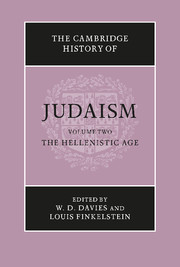Book contents
- Frontmatter
- 1 The archeology of Hellenistic Palestine
- 2 The political and social History of Palestine from Alexander to Antiochus III (333–187 B.C.E.)
- 3 Hebrew, Aramaic and Greek in the Hellenistic age
- 4 The Diaspora in the Hellenistic age
- 5 The interpenetration of Judaism and Hellenism in the pre-Maccabean period
- 6 The men of the Great Synagogue (circa 400–170 .b.c.e.)
- 7 Pharisaic leadership after the Great Synagogue (170 B.C.E.–135 C.E.)
- 8 Antiochus IV
- 9 The Hasmonean revolt and the Hasmonean dynasty
- 10 Jewish literature in Hebrew and Aramaic in the Greek era
- 11 Jewish–Greek literature of the Greek period
- 12 The Apocrypha and Pseudepigrapha of the Hellenistic period
- 13 The book of Daniel
- 14 The matrix of apocalyptic
- 15 The Septuagint and its Hebrew text
- 16 The Targumim
- 17 The Samaritans
- 18 The growth of anti-Judaism or the Greek attitude towards the Jews
- Bibliographies
- Chronological table
- Index
- References
6 - The men of the Great Synagogue (circa 400–170 .b.c.e.)
Published online by Cambridge University Press: 28 March 2008
- Frontmatter
- 1 The archeology of Hellenistic Palestine
- 2 The political and social History of Palestine from Alexander to Antiochus III (333–187 B.C.E.)
- 3 Hebrew, Aramaic and Greek in the Hellenistic age
- 4 The Diaspora in the Hellenistic age
- 5 The interpenetration of Judaism and Hellenism in the pre-Maccabean period
- 6 The men of the Great Synagogue (circa 400–170 .b.c.e.)
- 7 Pharisaic leadership after the Great Synagogue (170 B.C.E.–135 C.E.)
- 8 Antiochus IV
- 9 The Hasmonean revolt and the Hasmonean dynasty
- 10 Jewish literature in Hebrew and Aramaic in the Greek era
- 11 Jewish–Greek literature of the Greek period
- 12 The Apocrypha and Pseudepigrapha of the Hellenistic period
- 13 The book of Daniel
- 14 The matrix of apocalyptic
- 15 The Septuagint and its Hebrew text
- 16 The Targumim
- 17 The Samaritans
- 18 The growth of anti-Judaism or the Greek attitude towards the Jews
- Bibliographies
- Chronological table
- Index
- References
Summary
The purpose of this chapter is to demonstrate the high probability of the following propositions:
That the Men of the Great Synagogue (Hebrew, ‘anše keneset hagedolah) constituted a tribunal, which was the supreme judicial authority of the Pharisees in its time.
That the members of this tribunal and their followers considered it the body to which Deuteronomy 17:8ff referred in its command that a local judge or other authority in doubt as to the interpretation or application of the law should resort for guidance.
That this tribunal was called into being by Ezra and Nehemiah, in an effort to offset the authority of the court consisting of the Temple priests and the lay aristocracy, which gave Nehemiah so much trouble.
That the Great Synagogue claimed that its traditions derived from the prophets, and through them for Moses, having been revealed to him on Mount Sinai.
That another theory regarding the Great Synagogue ultimately developed, denying that it alone possessed such traditions, but ascribing to it supreme judicial authority, as the legitimate heir to the pre-exilic tribunal of Jerusalem, established by the kings of the Davidic dynasty.
That the rabbinic tradition, ascribing to this body the authority of Mishnah Sanhedrin 10.1, and the formulation of the central prayer of the Synagogue, as well as the most important home prayer, namely the Grace after the Meal, is authentic.
According to the prevailing rabbinic view, based on Mishnah Aboth 1.1, the Men of the Great Synagogue flourished between the time of the prophets and that of Simeon the Just, the high priest, who was a contemporary of Antiochus III of Syria.
- Type
- Chapter
- Information
- The Cambridge History of Judaism , pp. 229 - 244Publisher: Cambridge University PressPrint publication year: 1990
References
- 1
- Cited by



